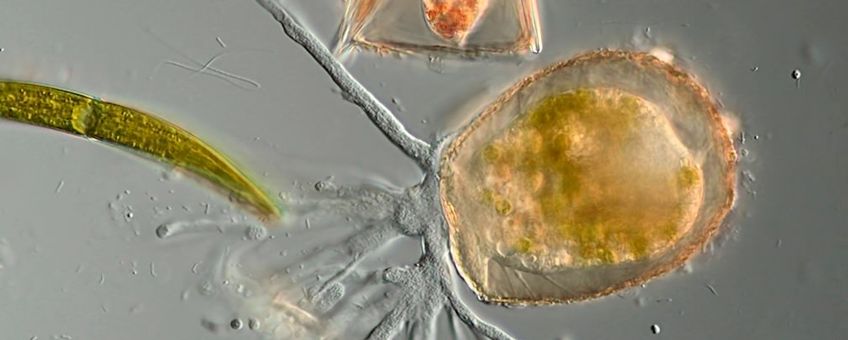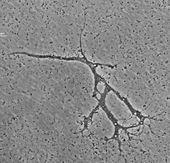
Protists: hidden majority in the soil
Netherlands Institute of Ecology (NIOO-KNAW)So what's a protist?! It's a question NIOO's protist-expert Stefan Geisen loves to answer. Any attention for the largely unknown yet crucial little creatures is more than welcome as far as he's concerned. You could say that protists are neither fish nor fowl. They're unicelllular, but don't belong to the domain of bacteria. In fact, protists are any 'eukaryotes' - as biologists call organisms whose cells have a nucleus containing their DNA - which aren't animals, plants or fungi. They form the vast but invisible majority of eukaryotic diversity in soils and any other ecosystem.
Central hub
 Different species carry exotic names such as Grossglockneria, Cafeteria, Darbyshirella or Vampyrella, and there's a dazzling variety of forms - from slender, gliding threads to compact boxes with armadillo-like plated armour. To take a proper look at them, you need a microscope. In fact, protists were the very first unicellular creatures to be observed in the 17th century by none other than Antoni van Leeuwenhoek, who invented the microscope.
Different species carry exotic names such as Grossglockneria, Cafeteria, Darbyshirella or Vampyrella, and there's a dazzling variety of forms - from slender, gliding threads to compact boxes with armadillo-like plated armour. To take a proper look at them, you need a microscope. In fact, protists were the very first unicellular creatures to be observed in the 17th century by none other than Antoni van Leeuwenhoek, who invented the microscope.
Protists can be found in all kinds of places, but Geisen focuses specifically on the soil, where they play a pivotal role. "Many protists are predators that feed on bacteria and fungi. They're actually the main consumers of bacteria. By preying on pathogens, they can help to keep plants healthy. In addition, they make the nutrients stored in their prey available for plant uptake. Plants can assimilate them directly, which makes them grow better." Other groups of protists such as micro-algae are themselves prey for animals and other protists, serving as a valuable resource of nutrients in belowground ecosystems. And other protists yet are parasites of plants, animals or other, larger protists, influencing the composition of the soil community and regulating population sizes. In short, this hidden group of soil inhabitants has an impact on the life in and functions of the soil far beyond the tiny size of its individual members. Want to assess soil quality? Protists are key indicators.
Black sheep
Healthy soil, in its turn, is necessary to provide a range of 'ecosystem services' that humans cannot live without - just think of food production. That's demonstrated dramatically by the relatively small number of cases in which protists play a more negative role. One such 'black sheep' in the protist family is Phytophthora infestans. It's particularly notorious for causing potato blight, which can remain dormant in the soil for years. Phytophthora infestans wrote history by being the biological culprit of the Irish Famine in the 19th century, which caused more than a million people to starve to death and prompted a mass exodus to the United States.
Four personas
 Considering the pivotal position of protists as an ecosystems hub, it may not be too far-fetched an idea to 'enlist' their services for steering the bacterial community in the soil. Practical applications could include boosting food production and preventing diseases. But where would one start? Not only are there hundreds of thousands of protists in a single handful of soil, there are myriad species classified in thirty to forty groups that have almost nothing in common with each other: they're hardly even related, and may differ in every conceivable aspect, from their life cycles to their modes of locomotion.
Considering the pivotal position of protists as an ecosystems hub, it may not be too far-fetched an idea to 'enlist' their services for steering the bacterial community in the soil. Practical applications could include boosting food production and preventing diseases. But where would one start? Not only are there hundreds of thousands of protists in a single handful of soil, there are myriad species classified in thirty to forty groups that have almost nothing in common with each other: they're hardly even related, and may differ in every conceivable aspect, from their life cycles to their modes of locomotion.
To get a better grasp, a functional distinction may be made between four main protist 'roles' or 'personas':
- The first includes species such as Acanthamoeba (pictured): phagotrophs that feed on bacteria, fungi, other protists and animals.
- Some other protists live as symbionts mutualists or parasites; this also affects soil biodiversity, as well as plants and aboveground animals.
- A third category is formed by 'saprotrophic' protists such as oomycetes, which degrade matter.
- Finally, phototrophic protists use light as a source of energy and are important for carbon fixation.
All of these 'personas' provide key roles for nutrient cycling in soils.
Scratching the surface
It's only been in the past two decades that we've begun to get some insight into the immense diversity of protists, thanks to the advent of new, molecular techniques. "But even now", says Stefan Geisen, "we're only scratching the surface". It will be up to latest DNA-sequencing techniques, which can retrieve unprecedented amounts of genetic information from the environment, to bring about a breakthrough. Already, massive efforts to describe protists are being undertaken in several laboratories around the world, with a special focus on function.
Geisen himself has just begun a three-year project funded by the Netherlands Organisation for Scientific Research to study the impact of soil biodiversity on plant performance, focusing primarily on soil protists. He'll be looking at up to 100 species at once: a diversity that to date has never been touched in diversity-functioning experiments. "Research in soil biology", Geisen concludes, "would clearly benefit from incorporating more protistology alongside the study of bacteria, fungi and animals. "Research into this hidden group of soil inhabitants is now on course to being placed at the centre of soil biology."

Text: NIOO-KNAW
Photos: Eckhard Völcker & Steffen Clauß (lead photo: Heleopera sphagni); Stefan Geisen
